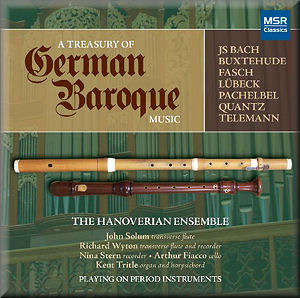 |
 |
|


alternatively
CD: MDT
AmazonUK
AmazonUS
|
A Treasury of German Baroque Music
Johann Joachim QUANTZ (1697-1773)
Sonata for recorder, transverse flute and bc in C (QV 2,2) [10:35]
Dietrich BUXTEHUDE (c1637-1707)
Prelude in C (BuxWV 137)* [5:11]
Georg Philipp TELEMANN (1681-1767)
Trio sonata for two transverse flutes and bc in A (TWV 42,A2) [7:49]
Johann PACHELBEL (1653-1706)
Fantasia in d minor* [2:48]
Johann Friedrich FASCH (1688-1758)
Sonata for two recorders, transverse flute and bc in G (FWV N,G1)
[8:36]
Vincent LÜBECK (1654-1740)
Preambulum in c minor (LübWV 6)* [4:32]
Georg Philipp TELEMANN
Sonata for two transverse flutes in e minor (TWV 40,146) [4:38]
Johann Sebastian BACH (1685-1750)
An Wasserflüssen Babylon (BWV 653)* [5:14]
Johann Joachim QUANTZ
Duet for two transverse flutes in a minor, op. 2,2 (QV 3,2.5) [8:51]
Johann PACHELBEL
Arietta with variations in F* [6:13]
 The Hanoverian Ensemble (Nine Stern (recorder), Richard Wyton (recorder,
transverse flute), John Solum (transverse flute), Arthur Fiacco
(cello), Kent Tritle (harpsichord, organ*))
The Hanoverian Ensemble (Nine Stern (recorder), Richard Wyton (recorder,
transverse flute), John Solum (transverse flute), Arthur Fiacco
(cello), Kent Tritle (harpsichord, organ*))
rec. 21-23 July 2009, Mary Anna Fox Martel Recital Hall, Vassar
College, Poughkeepsie, New York, USA. DDD
 MSR CLASSICS MS 1380 [64:32]
MSR CLASSICS MS 1380 [64:32]
|
|
|
The programming of this disc raises questions. Why are organ pieces played between chamber sonatas to which they have no connection? In his liner-notes John Solum comes up with an answer. "In selecting the music for this recording, our great interest was to choose works which would provide an hour or so of pleasurable listening. (...) The selection is also based upon the instrumentation of our chamber group, including the versatility of Kent Tritle as both an organist and harpsichordist". Fair enough, but it would have been a better idea to select different organ pieces, which in character and style are closer to the sonatas by Telemann, Fasch and Quantz.
There is at least some coherence within the two genres of music represented. Dietrich Buxtehude and Johann Pachelbel were two of the main influences on Bach's keyboard music. Both Buxtehude and Lübeck are representatives of the North-German organ school. One of its main features is its capriciousness, generally referred to as stylus phantasticus. This is amply demonstrated in both pieces, and comes off well in Kent Tritle's performances. These would have been even better with a more precise articulation and the use of agogical means. That also goes for the two pieces by Pachelbel. The Arietta with variations in F is characteristic of Pachelbel's oeuvre, in which variations play an important part. I am less impressed by the performance of Bach's chorale arrangement An Wasserflüssen Babylon (BWV 653). It is not speech-like enough, and the cantus firmus is not very clear, due to the registration. The booklet states that the temperament of the organ - after Herbert Anton Kellner, 1980 - is believed to be close to the temperament to which Bach himself tuned his instruments. In fact, there is no agreement whatsoever among experts in this field. Opinions highly diverge on what kind of temperament Bach preferred. Besides, this temparement is far less suitable for the earlier pieces. For the music of Pachelbel and Buxtehude and probably also that of Lübeck a mean-tone temperament would be more appropriate.
If one listens to this disc at a stretch, one needs to adapt the ears to the different sound levels. In particular because the rather soft transverse flute dominates in the chamber music, the contrast is quite dramatic. The flute builds the connection between the various pieces in the programme. Telemann, Fasch and Quantz were more or less contemporaries, and in the oeuvre of all three the transverse flute plays a major role. In the sonatas by Fasch and Quantz the flute plays alongside the recorder, and this makes for an interesting confrontation between 'old' and 'new', as it were. The recorder was frequently used in the 17th century, and was gradually replaced by the transverse flute, with its broader dynamic possibilities. It is a bit too bold, though, to state - as John Solum does - that the recorder by the middle of the 18th century "had all but been relegated to the dustbin of history - until Arnold Dolmetsch revived it early in the 20th century". In particular among amateurs the recorder was played well into the 19th century - and at that time even new music was written for it. In professional circles its role was marginalised. Whether the pieces by Fasch and Quantz are a tribute to the past or reflect the fact that the recorder was still in use is hard to say. The contrasting features of the two instruments are well exposed in these two pieces.
The least-known items on this disc are the two flute duets by Telemann and Quantz. The former, the Sonata in e minor (TWV 40,146) was discovered only fairly recently, when in 1999 the archive of the Berlin Singakademie was found and returned to Berlin. Pieces for two flutes without accompaniment were quite popular at the time, reflecting the ideal of a refined conversation.
These pieces are also the best items in the programme as far as performances are concerned. The others are well-played, technically and musically, but the performances are not really captivating. Solum writes that the flute had more capabilities in regard to gestural playing than the recorder. These performances are not very gestural, and the dynamic possibilities of the transverse flute are not fully explored. The use of agogics and a more differentiated treatment of the notes and the tempi would have made this disc more interesting.
All in all, this disc makes for pleasurable listening, but is not exactly engrossing.
Johan van Veen
http://www.musica-dei-donum.org
https://twitter.com/johanvanveen
|
|

